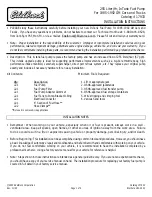
Child Safety
Important Safety Reminders
Never hold a baby or child on your
lap when riding in a car. If you are
wearing your seat belt, the violent
forces created during a crash will
tear the child from your arms. The
child could be seriously hurt or killed.
If you are holding a child and not
wearing a seat belt in a crash, you
could crush the child against the car's
interior.
Never put your seat belt over
yourself and a child. During a crash,
the belt could press deep into the
child, causing serious internal
injuries.
Two children should never use the
same seat belt. If they do, they could
be very seriously injured in a crash.
For their safety, do not leave
children alone in your car without
adult supervision.
General Guidelines for
Restraining Children Under
4 0 Ibs (18 kg)
Use an approved child seat.
The seat
must meet Federal Motor Vehicle
Safety Standard 213 (FMVSS-213) or
Canadian Motor Vehicle Safety
Standards. Look for the manufac-
turer's statement of compliance on
the box and seat.
Use a seat of the right size.
Make sure
the seat fits your child. Check the
seat manufacturer's instructions and
labels for height and weight limits.
Secure the child seat to the car.
A l l
approved child seats are designed to
be secured to the car seat by the lap
belt portion of a lap/shoulder belt. A
child whose seat is not properly
secured to the car can be endan-
gered in a crash.
To properly route a seat belt through
a child seat, follow the seat-maker's
instructions. Be sure to follow the
instructions for securing a child seat
with a lap/shoulder belt on page
23
.
Secure the child in the child seat.
Make
sure the child is firmly secured to
the child seat. Use the straps
provided, and carefully follow the
manufacturer's instructions.
Driver and Passenger Safety
















































